WARNING! SOME OF THESE PHOTOGRAPHS DEPICT MY SON
ANDREW DAVID SHEA
AT THE ACCIDENT SITE AND AT THE MORGUE
THESE DESCRIPTIVE PHOTOGRAPHS MAY CAUSE DISTRESS
THE CONTENT OF THIS PAGE IS NOT SUITABLE FOR CHILDREN UNDER THE AGE OF 18 YEARS
|
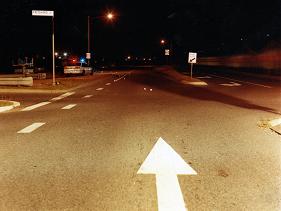 |
Image 001- The accident site - Click here for a larger image (Note: When you open the larger image, you can click on the "enlargement tool" for even a larger image for a detailed forensic examination of all aspects herein mentioned)
Intersection of Port Road and Pritchard Street, Lytton, Queensland, Australia (near the Port of Brisbane). Police photographic shot taken looking due west on Port Road as from John Phillips’ viewpoint approaching the directional arrow. John Phillips is the driver of the utility that had hit Andrew. The two tabs in the foreground mark the spot where there is a slight gouge/scratch mark on the road. Pritchard Street is to the left where it is claimed that Andrew had exited from. This is the position that Phillips stated in his statement that he was in when he saw “something coming from his left”. To the left of the directional arrow is another traffic island. The stop sign is on the street sign of Pritchard Street which can be seen in the upper left side of the photograph.
|
Note: For the collision point please refer to "Maps" imgages 46, 46(a), (b), (c). The collision point is west to the intersection next to the curb's edge on the left hand side of the road closeby to the street sign marked "Pritchard Street" |
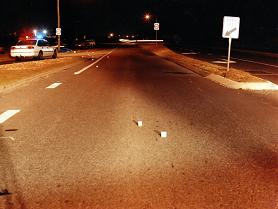 |
Image 002 - Click here for a larger image
The middle of the intersection where Fiore Zulli, John Phillips, Sergeant John Ruller, Constables Samantha Johnson and Ben Dyball had stated the collision had occurred. As can be seen there is no evidence of the collision in the middle of the intersection, that is there is no debris, no shattered glass from the broken left passenger door window (Img016); no bits and pieces of the bicycle chain (Img009); no broken pedal of the bicycle (Img009); no deep directional gouge marks traveling due west as the bicycle was dragged along the road under the utility’s left front wheel (Img033); no blood; no human matter at the intersection on the road. There are two short sharp tire marks from the bicycle on the curb’s edge of the traffic island to the left which show that the bicycle wheels had traversed this area of the traffic island. Constable Johnson confirmed in Court that there was no debris in the middle of the intersection. |
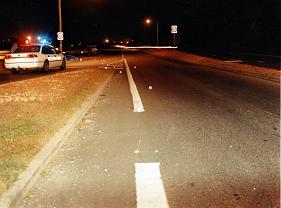 |
Image 003 - Click here for a larger image
In the foreground just above the white line, there are swerve marks to the right from another vehicle other than the utility involved in the accident. On the left side in the foreground on the curb’s edge is the utility’s left tire mark where the utility had mounted the curb’s edge. There is a single right tire skid mark on the road marked with white tabs. The corresponding left tire mark is in the grassed area of the traffic island. In the background, near in line with the 60 kilometers sign in the centre traffic island, to the left, is a sparkly bit of glass that had dropped off another vehicle as it was towed away. The single brake mark of the utility is seen in this photograph. The utility was traveling at 40 to 50 kilometers per hour when it had braked to a stop. At the hearing Constable Samantha Johnson said that there was glass, bits and pieces everywhere on the grassed area of the traffic island (Check transcript details of Constable Samantha Johnson Img054 under the header of "Transcripts".) |
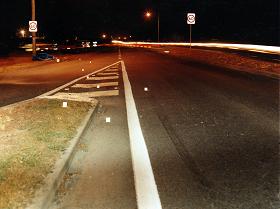 |
Image 004 - Click here for a larger image
There is blood on the grassed area of the traffic island where the white tab is. This is where Andrew was put on the grassed area next to the utility after he was removed from the back of the utility by Constable Ben Dyball and others. The white ticket on the grassed area of the traffic island is where Constable Samantha Johnson had located the broken bicycle pedal. Constable Samantha Johnson had given this broken pedal (Img041) to my sister, Margaret Samootin, after she had noted it in her note book. It can be seen that the left tire mark goes over the top of the traffic island. On the grassed area of the traffic island, there are round circular marks from the bicycle when it had been run over by the utility. There is a blue substance on the white cement of the traffic island. The same blue substance is on Andrew’s T shirt (Img018) and on the utility’s left front tire (Img010). In the background one can see Constable Samantha Johnson moving about waiting for another utility which is approaching on the road turning left to park next to the utility involved in the accident. A fragment of the rear licence plate can be seen. I traced the owner of the vehicle from this fragment plus that it was a blue utility. John Phillips’ ladders that were in the back of his utility, that Andrew had fallen on, were then placed in the blue utility’s rear tray. The ladders were then taken to this person's home for “safety reasons” by the driver of the utility. The owner of the blue utility was Deril Victor Banks, 25 Grassdale Road, Gumdale. When I telephoned Banks he said he "knew nothing". |
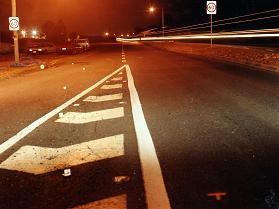 |
Img 005 - Click here for a larger image
Where the white tab is on the road in the foreground there is the liquid run off from the utility involved in the accident. The yellow T mark on the road is where the right tire brake mark of the utility ends. There is a spray of blood between the 2nd & 3rd ticket from the bottom of the photograph. This spray of blood comes from Andrew. This spray of blood is not marked. This spray of blood on the road indicates that Andrew was moved around at the accident site from where he was initially placed on the grassed area of the traffic island by Constable Ben Dyball. On the left side of the road, there is a line of blood covered with dirt in the area just prior to the crash helmet. Andrew had been moved from this spot to the final resting place and then photographed. This was done in order to falsify evidence to the public that Andrew had flown through the air for 45 meters in a straight line from the intersection, being hit by the utility going at a high speed. Near the 60 km/ph sign, on the road, there is a sparkly bit of glass that had fallen off from a vehicle. Just beyond the white utility involved in the accident there are swerve marks to the left, in all probability from the tow truck that had left the scene of the accident with a vehicle prior to the police photographs being taken. |
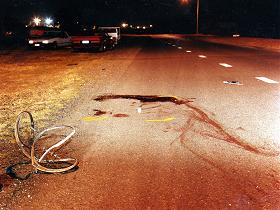 |
Img 006 - Click here for a larger image
Andrew was moved at the accident site (white ticket on traffic island in Img004), moved around the accident site and then moved to this spot and then photographed in this spot (Img018 & 019).
In the right area of the blood is where my sister, Margaret Samootin, had placed Andrew’s watch (Img043). She removed the watch after the police photographed it (Img039 & 043). The following day she had given me the watch (Img038) that she had washed in the washing machine to remove the blood, together with the bicycle’s broken pedal (Img041) and bits and pieces of the cogs of the bicycle chain.
To the right side of the blood on the road, just beyond the blood on the road, is a bit of debris from another vehicle that was towed away. The swerve marks from the tow truck are seen to the left just beyond the utility that was involved in the accident. The red Ford Falcon is parked behind the utility, concealing the rear of the vehicle involved in the accident. There appears to be broken glass reflecting on the road. The blue utility is parked next to the utility that was involved in the accident. The driver of this blue utility had taken home John Phillips’ ladders for “safety reasons” (Img004). |
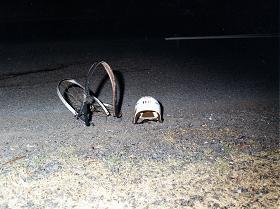 |
Img 007 - Click here for a larger image
The bicycle helmet is virtually undamaged. Andrew had the helmet on when the accident occurred. The helmet strap is buckled up. The helmet had slipped down onto the front of Andrew’s face. The bicycle’s left front wheel is mangled as it was wrapped around the utility’s left front wheel.
Note the sharp edges of the snapped wheel rim. There was no contact gouge marks from this area onto the area of the road where Zulli, Phillips, Sergeant John Ruller and Constables Samantha Johnson and Ben Dyball claimed the accident had occurred. But there are gouge marks on the utility’s left front wheel (Img010) and on the white painted cement area of the traffic island with the Pritchard Street sign on it (Img004, 033 & 042) which gives evidence that there was contact damage from the bicycle’s front wheel to these areas, that is the utility had traversed the grassed area of the traffic island and then over the cement area on top of the traffic island with the bicycle’s front wheel wrapped around its left front wheel. |
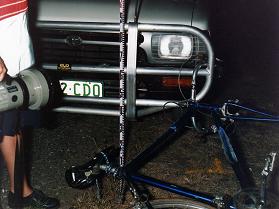 |
Img 008 - Click here for a larger image
The bicycle is hooked up to the left side of the bull bar by the right handle bar. Prior to the Coronial Inquest Friore Zulli had told me by telephone that John Phillips had hit Andrew from the rear when Andrew was positioned next to the traffic island on Port Road prior to reaching the intersection. There is contact damage from such a strike on the lower centre rung of the utility’s bull bar – that is a gouge mark from the bicycle’s metal rim of the rear wheel with a buff black tire mark. The height of the contact damage to the bull bar from impacting the rear of the bicycle is consistent with the height of the rear wheel of the bicycle (Img025). It was upon this contact damage that the rear bicycle wheel was pushed forward in the bicycle’s frame from the rear forks. The bicycle’s rear wheel had wobbled, making gouge marks with blue paint marks on the bicycle's rear wheel rim, and blue marks on the bicycle's back wheel tire’s edge (Img026).
Note: The directional scrape marks on the bicycle’s down tube in this image and refer to (Img031 & 032). |
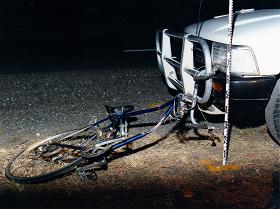 |
Img 009
- Click here for a larger image
The bicycle’s right handle bar is hooked onto the utility’s bull bar. The bicycle chain is broken. The right pedal has been snapped off. The bull bar is not in alignment. There are bicycle chain wheel marks on the utility’s left wheel.
The vehicle had been moved to this location for the police photographs to be taken.
There are blue marks from the bicycle on the left side of the mudguard. The lower edge of the mudguard had been pulled out as the bicycle was pulled out from underneath the utility. Sergeant Ruller admitted in evidence at the Coronial hearing that the bicycle had been pulled out from underneath the vehicle; the utility had then been reversed and the utility had been moved. Sergeant John Ruller did not determine from which location the bicycle and the utility had been moved nor when the alterations to the accident "trauma" had been carried out. |
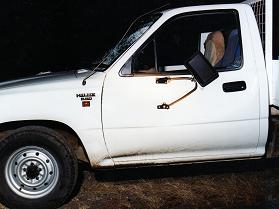 |
Img 010 - Click here for a larger image
There is a short sharp mark on the left wheel caused by the utility mounting the curb (Img003 & 037). There are chain wheel marks from the bicycle’s wheel on the utility’s front wheel (Img030). There is mud caked on the utility’s left front wheel. There are bits of grass in the left front tire tread. There is a blue substance on the utility’s left front tire – the same substance is on the white cement area of the traffic island (Img004) and on the collar of Andrew’s T shirt (Img018)
There is an impact dent on the upper pillar next to the windscreen of the utility. The aerial is bent backwards. There is a brown-red spray of dirt/blood on the body of the utility just behind the left front wheel. There are rivulets of water on the lower edge of the passenger door. Perhaps the passenger door had been washed. The wing mirror is pushed backwards. |
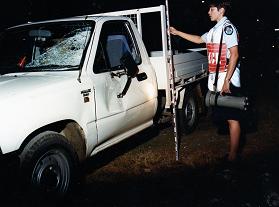 |
Img 011
- Click here for a larger image
The wing mirror is pushed into the vehicle’s passenger door.
There is a clean patch of spray of dirt on the vehicle’s body in the area behind the left front wheel. The question to ask - why is this so? |
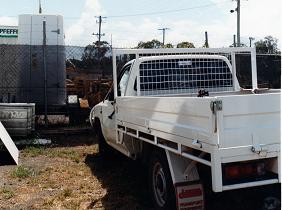 |
Img 012 - Photographs of the vehicle the day following the accident
Click here for a larger image
There is enough room between the left side of the bull bar and the body of the utility for the bicycle’s right handlebar to have been caught up as described - that is, from the rear with the vehicle approaching from behind (Img027, Img028 & 029). There is a blue mark from the bicycle on the upper edge of the bull bar which matches up with the position of the bicycle in (Img032). There are brown rivulets on the utility’s rear mud flap. The vehicle had been taken to the yards of Bayside Towing. The manager of Bayside Towing told me and my sister that he had washed the blood out of the back of the utility. When I examined a number of similar vehicle's rear tray, I noted drainage holes in the bottom of the rear tray. When I got to Bayside Towing with my sister, the vehicle had been taken away by the owner of the vehicle. I was given the damaged bicycle and the crash helmet.
At Bayside Towing I noted that there were two vehicles - a red one and a blue or green one being stripped of “fresh” damage. I suspected that these two vehicles were at the accident site. I had asked my sister, Margaret Samootin, if I could use her camera to take photographs of the vehicles. Margaret Samootin held the camera behind her back and refused to let me have the camera. |
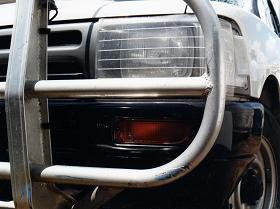 |
Img 013
- Click here for a larger image
There is a spider web like crack contact damage on the left side of the head lamp protector caused by contact with the tip of the bicycle’s right handlebar as it was hooked up by the utility from the rear (Img027, 028 & 029). The crack has dried blood in it.
On the left edge of the bulbar just above the centre rung, there is a metal gouge mark depecting a swing up and down mark indicating that the bicycle, when hooked up, had swing up and down ( Img029). There is black bicycle handlebar tape scrape mark near the area just mentioned which was scraped from the bicycle’s right handle bar on contact ( Img009 & 028). The directional trauma scrape marks from the bicycle on the left edge of the lower rung of the bull bar, was excellent for reconstruction work (Img031 & 032). |
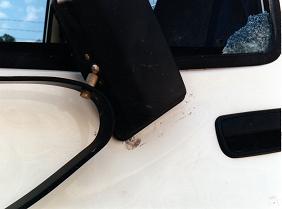 |
Img 014
Click here for a larger image
The wing mirror had been pushed into the left passenger door. There is a blue gouge mark together with a buff mark from the bicycle’s rear wheel (Img029). The gouge mark is from the metal rim of the bicycle’s wheel (Img026)
There are bits of shattered pieces of the left passenger window underneath the rubber of the window. |
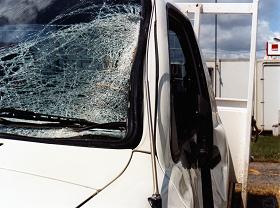 |
Img 015
- Click here for a larger image
This and the next two police photographs depict Andrew’s path of travel after he was thrown onto the left side of the windscreen. After hitting the windscreen, Andrew was then rotated to the left side of the utility and into the back tray of the utility.
There is human matter on the rubber edge of the windscreen. There are buff marks on the upright pillar. The rear pillar just past the left passenger door had been damaged when Andrew’s body brushed by that area. The aerial is bent backwards.
I had been told by Constable Ben Dyball immediately after the accident that Andrew had fallen into the back tray of the utility. I was told that Andrew was located there after someone had heard moaning from the rear tray of the utility. Andrew was still alive. Andrew was then moved by Constable Ben Dyball and others and placed on the grassed area of the traffic island next to the utility that had stopped there. |
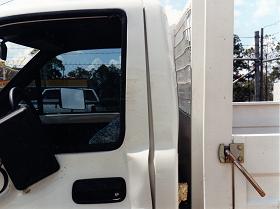 |
Img 016
- Click here for a larger image
There are directional blood and human matter marks on the upright pillar showing Andrew’s line of travel into the back tray of the utility. There is a spray of blood on the front edge of the rear tray. Constable Samantha Johnson had noted this spray of blood in her Coronial Report.
There is a directional shoe mark from Andrew’s shoe showing path of travel into the rear tray. The wire grid of the rear tray is distorted. I was told on the night of the accident that Andrew had fallen into the rear tray on top of some ladders. |
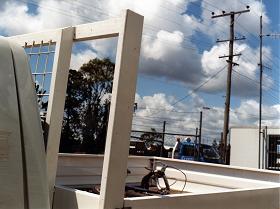 |
Img 017
- Click here for a larger image
There are Andrew’s directional blood and human matter marks going towards the back tray of the utility.
There is a spray of blood on the lower portion of the upright pillar of the utility tray.
This photographic evidence taken by Sergeant John Ruller confirms without a doubt that Andrew had fallen into the back tray of the utility.
Fiore Zulli, Sergeant Ruller, Constables Samantha Johnson and Ben Dyball had lied when they said that Andrew had flown through the air for 45 meters. Read about the Human Cannonball whose average distance when fired from a cannon is 43 metres and wherein he soares approximately 21 metres high. After reading this article you will get the gist of what I am stating and what I was told by a police officer that the theory of Andrew being a human projectile is rather "far fetched". In other words, Andrew was moved at the accident site to support the fake accident police theory of Andrew flying through the air for 45 metres after being hit in the middle of the intersection. |
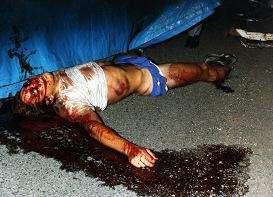 |
Img 018 - Andrew at the accident site
Click here for a larger image
Andrew’s jawbone is not broken and swollen. His mouth is parted open. Right eye is swollen shut. Tracheotomy installation is visible at the neck beneath the T Shirt. T Shirt is cut at the collar. There is evidence that a nose tube had been inserted into Andrew’s left nostril in the blood just under his left nostril. His lips are pale. There is an imprint of a man’s hand on his forehead as his head was tilted back (to keep the airway clear). There is a white chalk mark on the leg in the right knee area, which indicates that there was contact damage with white flakey paint on cement area of traffic island (Img004). Whip like mark on Andrew's left hip indicate contact damage with the utility’s aerial. There are horizontal injuries on Andrew's right knee area which indicate trauma of Andrew falling onto the ladders in the utility’s rear tray. There is bllue substance on Andrew's collar area of his T shirt. This is the same blue substance on white cement area of traffic island (Img004) and on the utility’s left wheel (Img010). There is debris from another vehicle below Andrew’s right foot. There is a bone protruding from front of the leg, which means rear impact hit.
Note: I had asked the cops – “For all the blood that is on Andrew and around Andrew, why isn’t there more blood on the vehicle. Who washed the utility clean?” I got no answer. |
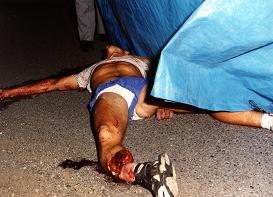 |
Img 019
Click here for a larger image
The structure of Andrew’s jawbone is clearly seen in this photograph. It is not broken. There is no swelling around the jawbone area. There is contact damage to Andrew’s rear calf. The flesh had been stripped off. View reconstruction Img027. It can be seen this is how the trauma to this area of Andrew’s body had occurred with a direct impact from the rear pushing the bone forward as is seen in the previous image. |
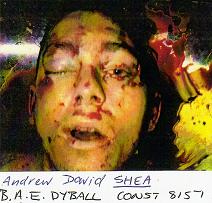 |
Img 020
- Police ID photograph
Police identification photograph of Andrew taken four hours after the accident at 10.50pm. Andrew's right eye is swollen. His mouth is parted open. His jawbone area is not fractured and swollen. Andrew is pale around the mouth. This is not a head and shoulders photo shot with identification dog tag around the neck, as should have been the case.
Constable Ben Dyball said at the inquest that they cleaned up Andrew’s face before he got to the morgue. Img018 shows Andrew with blood over his face. In this photograph Andrew’s face had been cleaned up.
Morgue records show that Andrew arrived at the morgue four hours after the accident at 10.50pm. I do not know of Andrew's whereabouts in the time factor of when he was removed from the accident site and taken to the morgue. There are no records.
Note: Some person had smashed Andrew’s jaw bone after this police identification photograph was taken. |
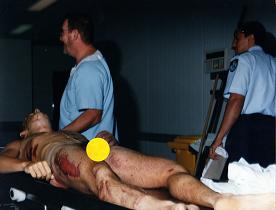 |
This photograph of Andrew was taken after the so called autopsy. The jawbone is fractured and swollen. Andrew had his jawbone fractured after the police identification photograph was taken. For the jawbone to have swollen as it did, Andrew was alive when it was broken. It takes the pumping action of the heart to push fluid to the tissue surrounding the fracture. This occurs to form a natural splint to the fracture while the bone starts to mend. There are tracheotomy wounds to Andrew’s throat.
If anyone knows who the two men are, please let me know.
If anyone knows what the machine is that is next to the person with the uniform on, please let me know. |
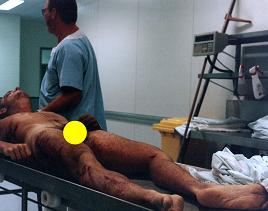 |
Img 022
It was shortly after this photograph was taken, that I saw Andrew at the morgue. I saw three tracheotomy wounds to his throat. I saw that the tissues around his jawbone area were swollen. I felt Andrew’s hands and held them. They were still warm and flexible, but cooling down. I knew that he had just been “freshly” killed, just before I saw him. I looked at his open eye. The dark brown was just a little lighter. Andrew did not have hypostasis. He was not refrigerated. He did not have moisture on the exposed parts of his body. Andrew had seven stitches to his jawbone area. In five of the stitches the blood had seeped through. Dead people do not bleed. I noted that some of the bruising on his faced was dissipating (going a yellow color). I noted a fresh blue bruise to his face. Andrew had lost weight. Andrew definitely looked skinnier. I picked up the sheet and looked underneath it. There was something missing from his chest. |
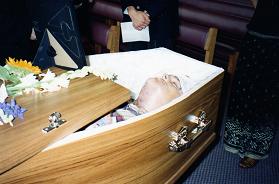 |
Img 023 - Andrew in his coffin
Click here for a larger image
Photograph of Andrew in his coffin. There is gross swelling to the jawbone and neck area. Andrew’s jawbone had been fractured after the police identification photographs were taken (Img020). It takes the pumping action of the heart to create the swelling around a fracture. Andrew’s bottom teeth are clenched over the top teeth, whereas the photographs of him at the accident site (Img018) and the police identification photograph (Img020) show him with his mouth parted open. There are three tracheotomy wounds to Andrew’s throat. The cops said that Andrew was killed instantly; but the evidence shows that he was kept alive and had sustained the fracture to his jawbone after the police identification photograph was taken. My poor dear son, Andrew David Shea, the illegal organ donor, died a horrible death.
Note: A week or two prior to the donation and his murder Andrew had been surfing at Byron Bay, enjoying life to the full. On the night of the accident, Andrew got his HSC results. He had passed with flying colours and had won a place at university to study. |
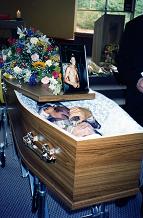 |
Img 024
The police and my sister told me that Andrew had gone through the intersection turning right and that he was hit by the utility.
I had expected to see Andrew’s right side of the body damaged that is the right wrist, right arm and the right hand, i.e. the cyclist cycling with his hands on the handlebars. I noted that there were no broken bones in Andrew’s wrists and hands when I felt them. I could move his fingers freely with my hands. They still felt like a live person’s hand, but just a little cool. Andrew’s structure of the right hand, right wrist and right arm were normal. |
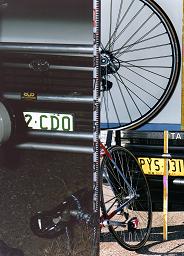 |
No one could tell me how the bicycle got hooked up to the bull bar. I was told by Wilton D Nelson (United States) to get a model bicycle the same size as the one involved in the accident; get a model vehicle the same type, year and make as the one involved in the accident; get the police photographs and match trauma site to trauma site - on the bicycle, on the utility and on Andrew.
This photographic shot shows that Andrew was hit from the rear by the utility, thus leaving on the bicycle’s rear wheel the gouge and buff mark on the bottom rung of the bull bar. Fiore Zulli told me on the telephone that he saw the utility following Andrew when both parties were on Port Road, next to the traffic island prior to the intersection. Friore Zulli said to me that he saw the utility hit the back of the bicycle. Fiore Zulli had told me that Andrew had cycled through the intersection with the vehicle following him. Then he saw the vehicle veer to the left and then to the left some more. |
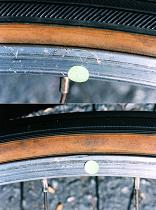 |
After the bicycle wheel was hit from the rear, the wheel had gone forward in the bicycle frame and had become dislodged from the rear end forks. The rear wheel had wobbled and hit the chain stays on either side. Gouge marks had occurred on the metal rim. The blue paint from the chain stays of the bicycle frame had transferred into the gouge marks on the wheel rim and the bicycle’s tire. |
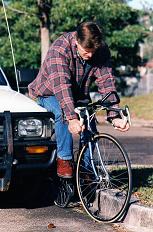 |
After Andrew had been hit initially from the rear, Andrew had cycled past the intersection and perhaps tried to jump the curb of the traffic island leaving two short black marks on the curb’s edge (Img001 & 002). Phillips had followed. Phillips had jumped the curb with the left tire of the utility and left tire marks on the curb’s edge (Img002 & 003) and a short sharp mark on the utility’s left front tire (Img010). The bull bar scraped past Andrew’s right thigh, leaving serrated flesh (Img018 & 021). The edge of the bull bar then hit Andrew’s right calf, stripping the flesh and breaking the bone. The broken bone was pushed forward. The bicycle’s right handlebar was hit by the utility’s left hand lamp protector leaving a spider web damage mark on it (Img013). Andrew then rotated onto the utility’s windscreen; then rotated onto the left passenger window and into the back tray of the utility.
Note: The position of the aerial near the model’s right rear end and compare it to the whip like mark on Andrew’s body on the right hip (Img018). |
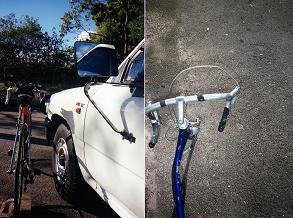 |
It can be seen that the bicycle was hooked up from the rear as a result of an impact from the rear. There is enough room for a bicycle’s right handlebar to fit through the gap (Img012).
The tip end of the right handlebar matches the impact damage on the utility’s left front head lamp spider crack mark. The handlebar has been pushed in towards the frame. There are serrated edges on the black tape on the outside of the handlebar which indicate that this part of the bicycle handlebar was scraped as it had come into contact with the body of the utility. |
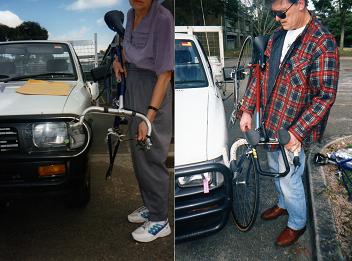 |
After the bicycle had been hooked up by the right handlebar the rear of the bicycle fishtailed and hit the utility’s left wing mirror. The impact to the wing mirror had left a gouge mark with blue paint from the bicycle’s rear wheel rim and a buff mark from the bicycle's rear tire as is seen in Img014. |
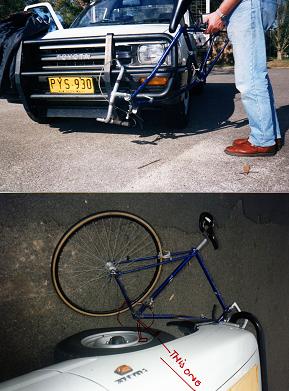 |
After hitting the wing mirror the bicycle then ricocheted to the front of the utility leaving marks on the front of the utility as is seen in Img013.
The bicycle’s front wheel went underneath the left front of the utility. The utility’s left wheel had run over the bicycle’s chain wheel. The chain wheel of the bicycle had left gouge marks on the utility’s left wheel as seen in Img010. The bicycle's chain had been broken.
The bicycle’s bottom bracket shell had snapped off its base as is seen in Img009. The circular imprints of the bicycle in the grassed area of the traffic island can be seen in Img003.
Note: At some time the bicycle's pedal had been snapped off and fell onto the grassed area of the traffic island where Constable Samantha Johnson had located it and marked it on her diagram. |
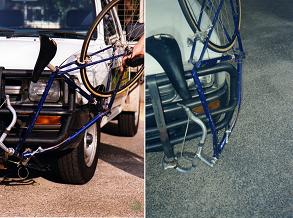 |
The bicycle’s front wheel had wrapped around the left tire of the utility (Img006, 007, 010 & 013) leaving contact damage on the utility.
Please note the position of the bicycle’s derailleur control in relation to the extreme lower edge of the bull bar and the gouge mark that had been left on the bull bar (Img013).
The rear end of the bicycle is sticking up. |
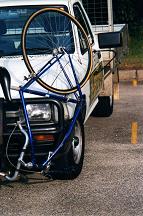 |
The damaged bicycle is wrapped around the end of the bull bar. As can be seen by the position of the bicycle’s front forks, the front wheel of the bicycle would have been wrapped around the left tire of the utility.
The bicycle is not being held by anyone. It fitted into this position like part of a jigsaw puzzle - a perfect fit of matching trauma site to trauma site.
Note: The position of the seat tube and note the blue color left on the utility’s bull bar in Img012. |
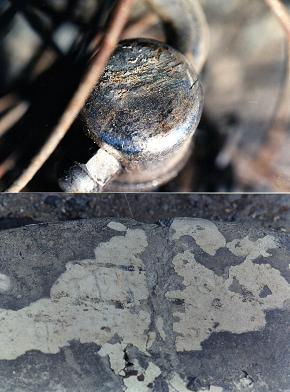 |
Img 033 - Click here for a larger image
I had photographed all parts of the bicycle with a macro lens. I noted that there was some white paint on the front wheel housing that matched the same white paint on Andrew’s right leg near the knee (Img018).
I went to the accident site. I looked for a match of the white paint. I located the match as the painted cement area on the grassed area of the traffic island, nearby where Constable Samantha Johnson had placed the white ticket (Img004). There were matching scrape marks from the bicycle’s front wheel housing and the bicycle’s blue paint in the white paint and the cement area of the traffic island. There were blue scrape marks. In Img004 the left tire imprint of the utility can be seen going over the top of the traffic island.
It was obvious that the driver of the utility had traversed this area with the bicycle’s front wheel wrapped around its left tire |
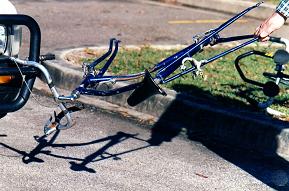 |
Img 034
- Click here for a larger image
John Phillips had stopped the utility where the brake mark had ended in Img005. Hands had pulled the bicycle out from underneath the utility. The utility and the bicycle were moved. The questions to ask are –
- How many hands assisted in the movement of the utility and the bicycle?”
- Why was the bicycle pulled out?
- Why was the vehicle moved?
- Why was Andrew moved?
At the Coronial hearing, Sergeant Ruller gave evidence that the bicycle and the utility had been moved. (See image 84 under the header of "Transcripts".) |
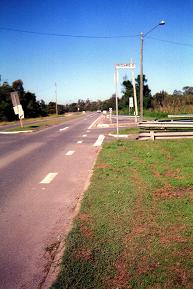 |
Img 035 - Click here for a larger image
This photograph was taken by me on Saturday, 2nd April 1994 – some 2.1/2 months after the accident. The circular marks from the bicycle’s wheel can be seen in the grassed area of the traffic island. There are marks leading up from the curb’s edge towards the base of the photograph.
I was told by a Wynnum police officer that if the left tire of the utility had run over the bicycle, then those marks would be in the earth for months after the accident. I rushed back home to Sydney. I looked at the photographs that I had taken after the accident had occurred. The police officer was right – the marks were there!
Note: This police officer could not explain to me why there were gouge/scrape marks on the utility’s left wheel from the bicycle, but no corresponding bicycle gouge/scrape marks on the road in the middle of the intersection. |
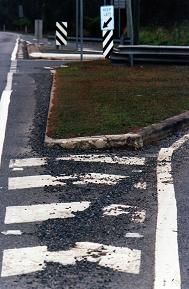 |
Img 036
- Click here for a larger image
This photograph was taken a year or two after the accident by me. The bicycle’s circular tire mark can still be seen embedded in the grassed area of the traffic island. The mark leading up to the bicycle’s circular tire mark can still be seen in the grassed area of the traffic island.
|
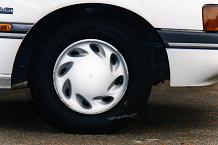 |
Img 037
- Click here for a larger image
I measured the curb height at the accident site where the utility had mounted the curb to hit Andrew. The height was between 11 to 14 centimeters. 11 centimeters was closer to the Pritchard Street sign. I then measured 11 centimeters on the model utility. It was the same height as in Img010 on the utility’s left wheel. This trauma on the utility's left wheel involved in the collision, had indicated that the driver of the vehicle, John Phillips, had mounted the traffic island. |
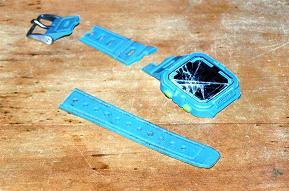 |
Img 038
- Click here for a larger image
My sister, Margaret Samootin, had given me Andrew’s watch the day after the accident. She told me that she had located it at the accident site on the grassed area of the traffic island. She told me that she had suggested to the police that she should put it in Andrew’s blood so that they could photograph it (Img006 & 043). The watch was placed in the position where Andrew’s head had been on the road and not in the hands and/or wrist area Img006. At the time I did not understand what she was talking about as I was literally "off" my face. but I remembered what she said. |
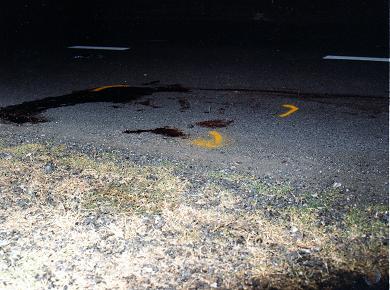 |
Img 039
- Click here for a larger image
Police photograph – different angle to Img006. There is debris from another vehicle just below the white broken line. It looks as though it could be part of a head lamp that had fallen off the vehicle that was towed away before the police photographs were taken.
I cannot see Andrew’s watch in this photograph. It looks as though my sister had removed it before this photograph was taken. |
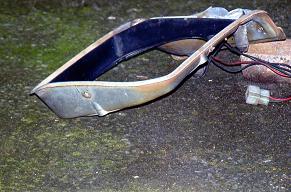 |
Img 040
This is part of a head lamp that I got from an old vehicle. It looks as though the debris in the preceding photograph (just below one of the white broken lines) and seen in Img006, may have come from a broken head lamp of another vehicle but without the end bit with the wires sticking out of it as depicted in this photographed "model". |
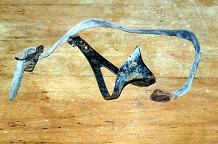 |
Img 041
This is the broken bicycle pedal and strap that Margaret Samootin had given to me the day after the accident. Margaret Samootin had said to me that Constable Samantha Johnson had given it to her after she had picked it up and noted it in her note book and marked the stop with a white tag as shown in Img004. Constable Samantha Johnson had noted the broken bicycle pedal in her Coroner’s Report as being on the grassed area of the traffic island in line with the stop line on Pritchard Street. The broken pedal is noted as Point 18 in Constable Johnson’s sketch of the accident site. The position of the broken bicycle pedal is noted with greater clarity in the surveyor’s plan of the accident site, as point 18. |
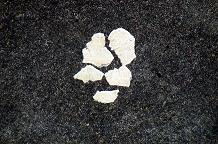 |
Img 042
This is the thick white paint that I had taken off the white area of the traffic island with the Pritchard Street sign on it (Img004). This is the same white paint that is seen in the photograph of Andrew at the accident site in Img018 and the bicycle’s hub nut (Img033).
The evidence shows that contact damage had occurred between the three points, i.e. Andrew’s knee area, the front wheel of the bicycle and the white cemented area where the bicycle’s front wheel had scraped by. |
 |
Img 043
- Click here for a larger image
Color photocopy from the large police photograph (Img006) of Andrew’s watch at the accident site. This is the watch that my sister, Margaret Samootin, had given to me the day after the accident. My sister said that she had got it from the accident scene. See image 038 for further details. |